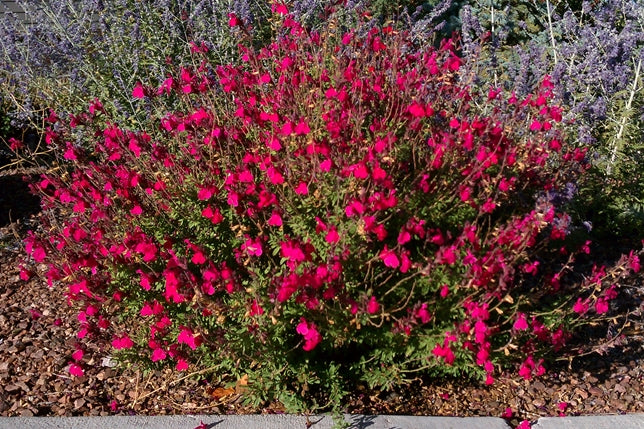Autumn sage, also known as Salvia greggii, is a popular perennial plant prized for its vibrant flowers, long blooming season, and drought tolerance One important aspect to consider when choosing an autumn sage plant is its size. Depending on the variety, autumn sage plants can range from compact and petite to large and sprawling Selecting the right size for your garden or landscape is crucial to ensure that the plant thrives and fits harmoniously with its surroundings.
Factors to Consider When Selecting Autumn Sage Size
There are a few key factors to take into account when deciding which autumn sage size is best for your needs:
-
Available Space – Consider how much room you have to accommodate the mature size of the plant. Compact varieties are great for small gardens while large varieties make bold statements in bigger landscapes.
-
Growing Conditions – Make sure to choose a size suitable for your climate and soil conditions. Some varieties may be more cold hardy or drought tolerant than others.
-
Desired Visual Impact – Decide if you want the autumn sage to be a focal point or a supporting player, Larger varieties create drama while smaller ones blend in more discreetly,
-
Surrounding Plants and Structures – Choose a size that complements other elements in your garden without overwhelming them. Avoid varieties that will outgrow their space.
Compact Varieties
Compact autumn sage varieties reach 1 to 2 feet tall and wide when mature. Despite their petite stature, they produce colorful blooms that draw in pollinators. Popular compact varieties include:
- ‘Hot Lips’ – Red and white bicolor blooms
- ‘Furman’s Red’ – Vibrant red flowers from spring to fall
Compact varieties are perfect for:
- Small gardens
- Containers
- Tight spaces
- Edging walks and borders
- Accenting rock gardens
These plants need minimal pruning to stay tidy and are easy to maintain.
Medium-Sized Varieties
Medium-sized autumn sages grow 2 to 3 feet tall and wide. They’re versatile options for:
- Flower borders
- Mixed perennial beds
- Xeriscape gardens
Popular medium varieties include:
- ‘Black and Blue’ – Deep purple flowers with black calyxes
- ‘Maraschino’ – Vivid cherry red blooms
These plants may need occasional pruning but add nice height and structure to garden beds.
Large Varieties
Large autumn sage varieties can reach heights over 3 feet with a spread of 4 to 5 feet. Their substantial size makes them ideal statement plants for:
- Accenting large landscapes
- Anchoring perennial borders
- Creating focal points
Some popular large varieties are:
- ‘Wild Thing’ – Abundant coral pink flowers
- ‘Navajo Sunset’ – Bi-colored orange and pink blooms
These plants command attention and may require pruning to maintain their shape.
Tips for Choosing the Right Size
When deciding which autumn sage is the right size for your needs, keep these tips in mind:
- Select compact varieties for tight spaces and containers.
- Go for medium or large sizes to make bold statements in garden beds.
- Consider the plant’s mature size, not just how it looks when young.
- Choose a size that fits proportionately within your existing landscape.
- Make sure the plant has enough room to reach its full size without being crowded.
- Balance having enough space with achieving your desired visual impact.
With their long bloom season and drought tolerance, autumn sages are star players in both small-scale and grand gardens. Taking the time to select the proper size will ensure yours thrives. Give your autumn sage the right conditions and care for its size, and it will reward you with vivid flowers year after year.

DescriptionAutumn Sage is native to Western Texas and parts of New Mexico and Southern Arizona. It is a small, evergreen shrub that grows to about 3 feet tall and wide. Its small, dark green leaves have a slightly sticky coating. Showy, 1 inch long flowers appear on 6-10 inch long spikes in the spring, summer and fall. Autumn Sage is available in a wide range of flower colors including red, pink, fuschia, purple, orange, yellow and white. The hot pink and the fuschia flowering varieties are the most heat tolerant. Its compact size, rich green leaves, long bloom period and profusion of hummingbird attracting flowers have made this little shrub a mainstay in many Southwestern gardens. Use Autumn Sage in container gardens, planters or as a border for landscape color.





August Companion Plants – Autumn Sage
FAQ
How big does Autumn Sage get?
Where is the best place to plant Autumn Sage?
How big will my sage plant get?
Should Autumn Sage be cut back in the fall?
How big do autumn sage flowers get?
Reaching roughly 3 feet (1 meter) in both height and width at maturity, these native plants are ideal candidates for wildflower gardens and for use in conventional flower gardens. Though red cultivars are most common, autumn sage flowers can be found in a wide range of colors.
How to grow autumn sage?
Autumn Sage is a popular plant among gardeners because of its beautiful flowers and ease of care. Here are some tips on how to grow Autumn Sage: Choose the right location: Salvia greggii prefers full sun to partial shade and well-drained soil. Make sure to choose a location that gets at least 6 hours of sunlight a day.
What is autumn sage?
Autumn Sage, also known by its scientific name Salvia greggii, is a beautiful and versatile plant that can add a pop of color to any garden or landscape. This plant is native to the southwestern United States and Mexico, and is well known for its vibrant flowers and aromatic foliage.
Does autumn sage need more humidity?
Autumn Sage doesn’t require additional humidity. Plants absorb most water through their root system rather than their leaves, so the best way to provide humidity for your plants is through watering the soil. Autumn Sage does best in well-draining soil.
